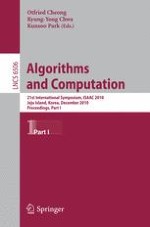2010 | Book
Algorithms and Computation
21st International Symposium, ISAAC 2010, Jeju Island, Korea, December 15-17, 2010, Proceedings, Part I
Editors: Otfried Cheong, Kyung-Yong Chwa, Kunsoo Park
Publisher: Springer Berlin Heidelberg
Book Series : Lecture Notes in Computer Science
